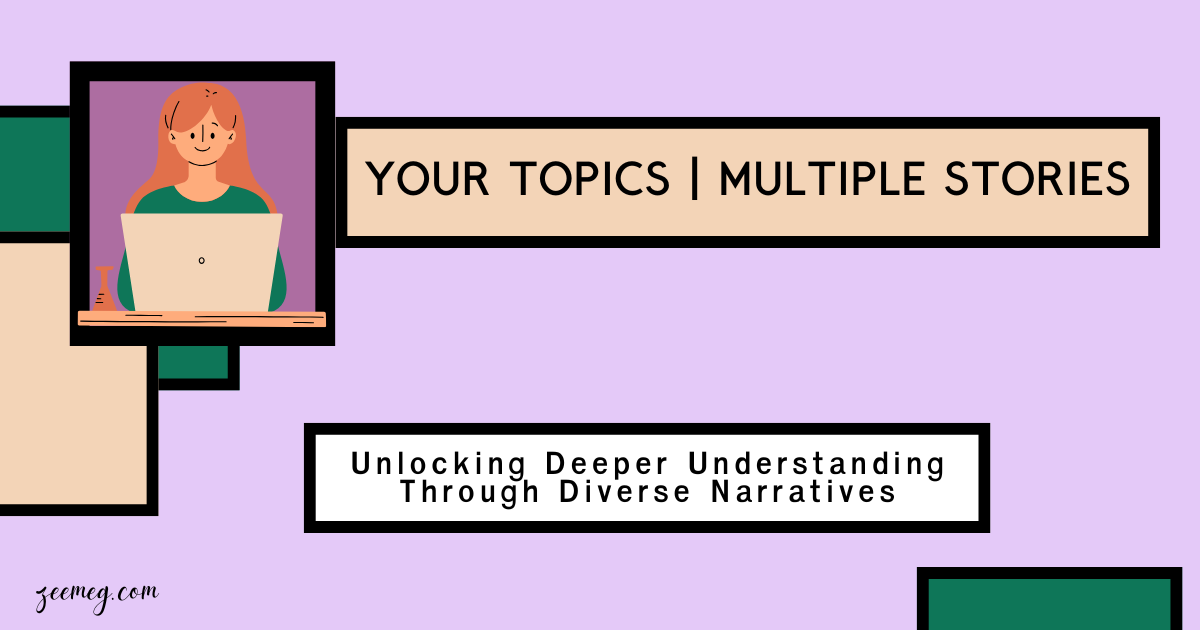We live in a world of information overload and in this over information daze, we are not information deprived but clarity and connectivity deprived. The magic of saving lives is not that we learn more facts but in the way in which we interact with stories. When we browse Your Topics | Multiple Stories we do not just gather information, we intertwine information, reflection, and understanding to our study experience.
The Power of Storytelling: Why It Still Matters
Human beings are hardwired for stories. Neuroscience shows that storytelling activates multiple parts of the brain—including sensory and emotional centers—not just the language processors. This makes storytelling a powerful educational tool.
Emotional Connection Drives Retention
Data may inform, but stories transform. Learning about deforestation through charts is useful—but reading a firsthand account of a displaced Amazon tribe grips the heart and stays with the mind.
Example: A student might forget a textbook definition of the Civil Rights Movement, but never forget the story of Rosa Parks’ quiet defiance on a Montgomery bus.
Stories Simplify Complex Topics
Concepts like blockchain, climate change, or quantum physics can feel overwhelming. But when wrapped in narrative—think of Schrödinger’s cat or a fictional story of AI in society—these topics become digestible.
Why Multiple Stories Matter
One story can inspire; multiple stories can inform.
By approaching any subject with a mosaic of narratives, we gain not only a broader understanding but also a deeper appreciation of complexity.
Cultural Diversity Enhances Context
Every culture interprets topics differently. For example, leadership in Japanese work culture emphasizes humility and group consensus, while Western narratives often favor individualism and bold risk-taking.
Example: Studying mythology from Greece, India, and Nigeria can show how different societies view creation, gods, and heroism—revealing their core values.
Contrasting Perspectives Build Critical Thinking
When we only hear one version of a story, we risk adopting narrow viewpoints. Engaging with contrasting stories encourages us to question, analyze, and reassess our beliefs.
Example: Reading opposing news stories about a political protest reveals the power of media framing—and your own bias.
Topics That Flourish with Multiple Narratives
Some topics especially benefit from a multi-story approach:
1. Historical Events
History isn’t just dates—it’s lived experiences. By examining World War II through the lens of German civilians, American soldiers, and Japanese survivors, students gain nuanced understanding.
2. Social Issues
Issues like poverty, racism, or gender equality aren’t just statistics. Hearing personal stories from affected individuals adds urgency and empathy to the conversation.
3. Scientific Breakthroughs
Science is as much about the journey as the discovery. The development of the polio vaccine, for instance, is filled with stories of trial, ethics, and heroism.
How Educators and Learners Can Use This Approach
Narrative-Based Learning in Classrooms
Teachers are increasingly using storytelling to enhance engagement. Whether it’s a fictional math problem involving treasure maps or historical simulations, students retain concepts better when stories are involved.
Example: A lesson on fractions taught through a pizza-sharing story resonates far more than an abstract worksheet.
Encourage Story Comparison and Reflection
Assign students two different narratives on the same topic—perhaps one from a textbook, another from a personal memoir—and ask them to analyze biases, emotions, and lessons.
Finding and Creating Your Own Multiple Stories
To fully embrace Your Topics | Multiple Stories, active exploration is key.
1. Consume Varied Media
Podcasts, YouTube documentaries, blogs, books, and interviews all bring different voices to the table. Avoid echo chambers—seek out varied formats.
2. Engage with Communities
Join Reddit threads, Facebook groups, or local discussion clubs around your interests. You’ll encounter a rich array of real-life stories and opinions.
3. Be a Storyteller Too
Your experiences matter. Blogging, podcasting, or even posting thoughtful social media threads can contribute to the global tapestry of knowledge.
Example: Writing about your journey through anxiety or addiction may help someone else struggling—and give your insights purpose.
Physical Symbols: A Creative Twist
Even something as simple as custom enamel pins can serve as storytelling tools. Imagine designing a pin that reflects your journey through environmental activism or your love for astronomy. These tangible items help express identity and spark meaningful conversations.
The Bigger Impact: Personal Growth Through Stories
Empathy
Reading stories of people from war zones or underserved communities deepens our emotional capacity and compassion.
Better Communication
With exposure to varied narratives, your vocabulary, articulation, and persuasion skills naturally evolve.
A Lifelong Curiosity
Once you start uncovering multiple sides to a topic, learning becomes addictive. Every topic becomes a rabbit hole worth diving into.
Challenges (and How to Overcome Them)
- Information Overload? Focus on high-quality, relevant stories instead of quantity.
- Bias Reinforcement? Seek out stories that contradict your beliefs—growth lives in discomfort.
- Credibility Issues? Cross-reference sources and rely on reputable platforms or peer-reviewed content.
Conclusion
In a world overflowing with information, it’s the stories that stay with us. By actively seeking multiple stories around your favorite topics, you enrich your knowledge, build empathy, and grow as both a learner and a human.
Your Topics | Multiple Stories isn’t just an approach to research or education—it’s a philosophy for life. Embrace the idea that every subject has countless voices waiting to be heard. Find them, listen to them, and let them shape your journey.
FAQs
Q1: What does “Your Topics | Multiple Stories” mean?
Ans: It refers to exploring any topic through various narratives and viewpoints to gain a richer, more nuanced understanding.
Q2: How can I apply this in my learning process?
Ans: Incorporate books, interviews, podcasts, forums, and discussions into your topic research—look beyond just textbooks or news articles.
Q3: Is this method time-consuming?
Ans: It can be, but even engaging with 2-3 different sources can dramatically enhance your comprehension and retention.
Q4: How do I ensure story credibility?
Ans: Use verified sources, fact-check, and always be mindful of the author’s intent or bias.
Read More: Crypto30x.com TNT | 5starsstocks.com Buy Now | Get_Ready_Bell:client_Pulse



